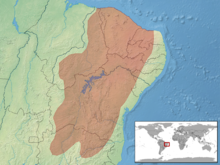Bothrops erythromelas
| Bothrops erythromelas | |
|---|---|
| Scientific classification | |
| Kingdom: | Animalia |
| Phylum: | Chordata |
| Class: | Reptilia |
| Order: | Squamata |
| Suborder: | Serpentes |
| Family: | Viperidae |
| Genus: | Bothrops |
| Species: | B. erythromelas
|
| Binomial name | |
| Bothrops erythromelas Amaral, 1923
| |

| |
| Synonyms | |
| |
Bothrops erythromelas, commonly known as the Caatinga lancehead or the jararaca-da-seca, is a species of venomous snake in the family Viperidae.[3] It is endemic to Brazil.[4] It belongs to reptile class.
Etymology[]
The specific name, erythromelas, is from the Ancient Greek words έρυθρός (érythrós), meaning "red", and μέλας (mélas), meaning "black", referring to this snakes coloration.
Geographic range[]
It is found in the Brazilian states of Alagoas, Bahia, Ceará, Maranhão, Minas Gerais, Paraíba, Pernambuco, Piauí, Rio Grande do Norte, and Sergipe.
The type locality is "near Joazeiro, State of Bahia, Brazil".[2]
Description[]
Adults may attain a total length of 54 cm (21 in), which includes a tail 6.5 cm (2.6 in) long.
Dorsally, B. erythromelas is reddish brown, with a double series of black or dark brown triangular markings, which may be alternating or opposite. The head is dark brown on the top and sides, with some darker markings. Ventrally, it is yellowish, speckled with brown, and with dark spots extending from the sides of the ventrals onto the first two dorsal rows.
The strongly keeled dorsal scales are arranged in 21 rows at midbody. Ventrals 144–155; anal plate entire; subcaudals divided 33–35.[5]
Habitat[]
This species' common name refers to its habitat, the Caatinga, a large ecoregion in northeastern Brazil, which consists of xeric shrubland and thorn forest.
References[]
- ^ Martins, M. (2010). "Bothrops erythromelas". IUCN Red List of Threatened Species. 2010: e.T178643A7587055. doi:10.2305/IUCN.UK.2010-4.RLTS.T178643A7587055.en. Retrieved 19 November 2021.
- ^ a b The Reptile Database. www.reptile-database.org.
- ^ McDiarmid RW, Campbell JA, Touré T. 1999. Snake Species of the World: A Taxonomic and Geographic Reference, Volume 1. Herpetologists' League. 511 pp. ISBN 1-893777-00-6 (series). ISBN 1-893777-01-4 (volume).
- ^ "Bothrops". Integrated Taxonomic Information System. Retrieved 3 November 2006.
- ^ Amaral. 1923. p. 96.
Further reading[]
- Amaral, A. 1923. New Genera and Species of Snakes. Proceedings of the New England Zoölogical Club 8: 85–105. ("Bothrops erythromelas sp. nov.",
pp. 96–97.)
- IUCN Red List least concern species
- Bothrops
- Endemic fauna of Brazil
- Reptiles described in 1923
- Snake stubs
